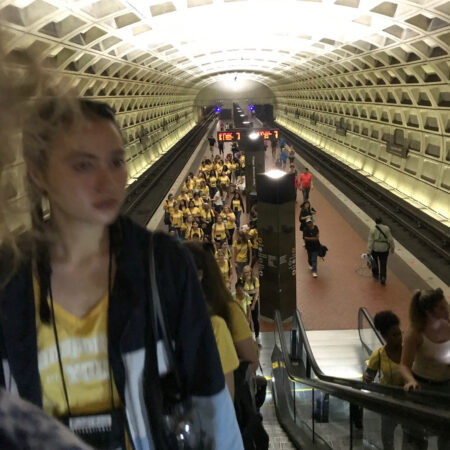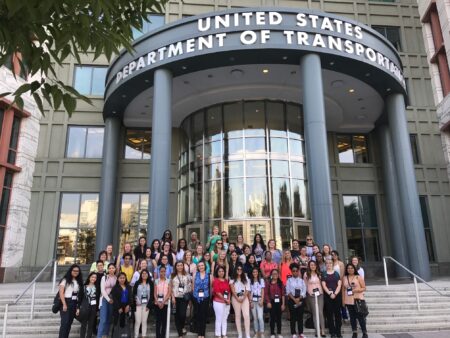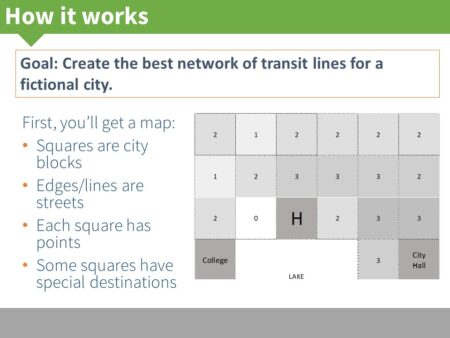Transportation planning is all about preparing for the future. It’s not uncommon for planners to design rail lines that will not break ground for 40 years, or to create bus routes that won’t exist for 20 years. As we focus on serving the next generation of users, we cannot forget the importance of also educating the next generation of planners. Over the past year, Foursquare ITP spoke with high school students at Laurel High School and helped lead the Women’s Transportation Seminar’s Transportation YOU program DC Summit to encourage younger generations to think about transportation planning as a career option.
Going Back to High School – by Alex Cohen
In May, my coworker Wylie Timmerman and I went to Laurel High School to speak with students about our careers. As I stood in front of the classroom, I was overcome with nerves; could we really make transportation planning ‘cool’ to high school students? To my complete and utter surprise, we could.
We started our talk with a crash course in transportation planning, explaining the various strategies Foursquare ITP uses to plan a variety of public transportation modes. Some of these strategies include analyzing demographic data; looking at trip patterns; reviewing existing levels of transit service and their ridership; and reaching out to the public to get their input.
We spoke about the dynamic nature of our field: the proliferation of ride hailing services like Uber/Lyft, the future of autonomous vehicles; and the myriad funding, design, and environmental issues facing agencies across the county. The students asked engaging questions about Metro’s service cuts, why only one bus route served their school, what bikeshare is, and how to ride the bus safely.
It was exciting for us to see their minds work and showed us how interesting planning can be for a teenager if given the opportunity to learn about it. At the end, we reflected on the students designs, noting the challenges they faced and the pros and cons they weighed in their decision-making process. We also highlighted the differences in each groups transportation network to show how many options there can be when planning a transportation network.
At the end of our talk, we spoke about our career paths. I realized, when I was a teenager, I knew nothing about transportation planning. Many planners stumble across this field later in life: in a college class, through a friend, or a community organization. In that moment, I realized how important it is for us to get into the community and talk to the next generation. It’s something that should be prioritized, and I hope there are more opportunities for me to do this in the future.
An Intense Five-Day Experiential Learning Program – by Lora Byala

Following my participation in the 2016 Women’s Transportation Seminar (WTS) DC Summit, I served as the chair of the program in 2017, working hand-in-hand with the wonderful staff of WTS and some amazing volunteers from other companies and agencies. On June 21, 27 high school girls, the mentees, and 27 professional women from various fields within transportation, the mentors, convened in Washington, DC from across the country. We held a jam-packed, five-day summit of learning about the various aspects of transportation planning and engineering, working on team projects, and having a lot of fun!
We held workshops and seminars on diverse topics in the transportation field – including visits to UDSOT, the National Transportation Safety Board, the FHWA’s Turner Fairbank Highway Research Center – and in the professional development area, such as developing their personal mission statements, learning how to make professional introductions, and how to confidently make presentations. The students also had the opportunity to work on a team “challenge project,” where they conducted research and presented their results to the rest of the group. Finally, we found time for fun activities, including an “Amazing Race” style hunt on the National Mall and a Potomac River dinner cruise.

Throughout the five days, I was impressed with how many of the girls were in a high school engineering-focused program, something almost non-existent when I was in high school almost 30 years ago. They were learning at a young age some of the skills they need to be able to move forward in such an important and interesting field. The summit provided them an opportunity to see how those skills could be applied to transportation – and it seemed like their eyes were opened to a field that could combine the hard skills they are learning in school with some of the softer skills required in transportation, such as human behavior and policy.
Seeing these girls, who didn’t know one another before starting the program, become friends and find like-minded people their own age was such an inspiration, and gives me hope that the future is bright. The summit was a great success – it was interesting, engaging, fun, and when it ended the girls felt very connected to both one another, their mentors, and the transportation field. As for me, it was a pleasure to see a bunch of polite, appreciative, and strong young ladies truly embracing the program we had worked so hard to plan – and we managed not to lose anyone or leave them behind throughout our back-to-back activities and travel all over the DC area over the five days!
Preparing for the Future
Teaching the next generation to be interested in and think critically about transportation is important in making transportation stronger and better for all users. By engaging young adults in conversations about these issues we encourage them to become active citizens in their communities, whether that be as a planner, an engineer, a community activist, or a public meeting attendee. When we explain how we do our work and the challenges of the field, it helps students understand how these systems work, why they are set up as they are, and gets them thinking about ways to do things differently. It is these conversations that help us all shape our future.
